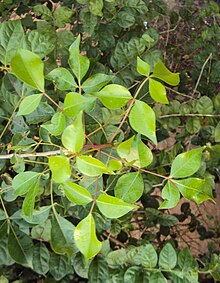
Mesua ferrea, the Ceylon ironwood, or cobra saffron, is a species in the family Calophyllaceae. This slow-growing tree is named after the heaviness and hardness of its timber. It is widely cultivated as an ornamental due to its graceful shape, grayish-green foliage with a beautiful pink to red flush of drooping young leaves, and large, fragrant white flowers. It is native to wet, tropical parts of Sri Lanka, India, southern Nepal, Burma, Thailand, Indochina, the Philippines, Malaysia and Sumatra, where it grows in evergreen forests, especially in river valleys. In the eastern Himalayas and Western Ghats in India it grows up to altitudes of 1,500 m (4,900 ft), while in Sri Lanka up to 1,000 m (3,300 ft). It is national tree of Sri Lanka, state tree of Mizoram and state flower of Tripura.

Diospyros melanoxylon, the Coromandel ebony or East Indian ebony, is a species of flowering tree in the family Ebenaceae native to India and Sri Lanka; it has a hard, dry bark. Its common name derives from Coromandel, the coast of southeastern India. Locally it is known as temburini or by its Hindi name tendu. In Odisha, Jharkhand, and Assam, it is known as kendu. The leaves can be wrapped around tobacco to create the Indian beedi, which has outsold conventional cigarettes in India. The olive-green fruit of the tree is edible

The genus of the myrrhs, Commiphora, is the most species-rich genus of flowering plants in the frankincense and myrrh family, Burseraceae. The genus contains approximately 190 species of shrubs and trees, which are distributed throughout the (sub-) tropical regions of Africa, the western Indian Ocean islands, the Arabian Peninsula, India, and Vietnam. The genus is drought-tolerant and common throughout the xerophytic scrub, seasonally dry tropical forests, and woodlands of these regions.
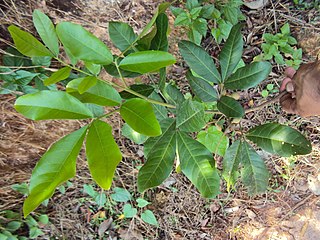
Aglaia elaeagnoidea, the droopy leaf or priyangu, is a species of plant in the family Meliaceae. It is a 10m tall tree found in American Samoa, Australia, Cambodia, India, Indonesia, Malaysia, New Caledonia, Papua New Guinea, the Philippines, Samoa, Sri Lanka, Taiwan, Thailand, Vanuatu, and Vietnam.

Mangifera zeylanica or “Sri Lanka wild mango” is a wild species of mango tree endemic to Sri Lanka. This stately tree is the tallest member of the mango genus, Mangifera, and one of the two tallest trees in the family Anacardiaceae. The mango fruits are edible and have an excellent taste. It is called "aetamba" (ඇටඹ) or "wal amba" in Sinhala and “kaddu-ma” in Tamil. The well-known British botanist and explorer Joseph Dalton Hooker first described the tree in 1876.

Syzygium caryophyllatum is a species of plant in the family Myrtaceae.

Rotheca serrata, commonly known as the blue fountain bush, the blue-flowered glory tree or the beetle killer, is a species of flowering plants in the family Lamiaceae. It is native to India, Sri Lanka and Malaysia.
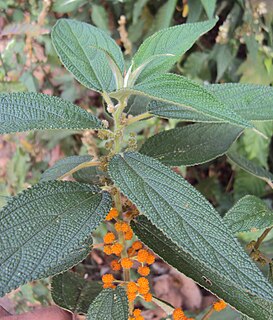
Debregeasia longifolia also known as Orange Wild Rhea is a large shrub growing up to a height of 5 meters seen in wet areas from plains to 1000m. Commonly found in India, Sri Lanka, Myanmar, Indo-China, W.China and Malesia. Its wood is used for making charcoal and fiber used for fishing-lines. The fiber extracted from bark is used for house construction.

Discospermum sphaerocarpum is a small tree of family Rubiaceae that is endemic to Sri Lanka. Sometimes due to various classifications it is accepted that the plant is also found in India. In Sri Lanka, this endemic species is commonly known as Tricalysia dalzellii in text books and field guides.
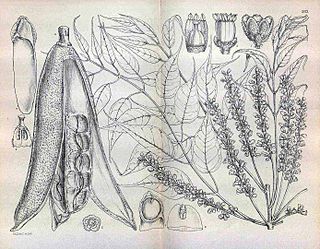
Entandrophragma caudatum, or mountain mahogany, is a large Southern African tree belonging to the mahogany family and found in eastern and north eastern South Africa, Swaziland, Botswana, Angola, the Caprivi Strip region of Namibia, Zimbabwe, Zambia and Malawi. Kew currently recognises 12 other species of Entandrophragma, all with a tropical and sub-tropical African distribution.
Microtropis wallichiana is a species of small tree in the family Celastraceae. It is native to India and Sri Lanka. Its leaves are simple, opposite, decussate, and estipulate. The tree is about 15m high. Branchlets are yellowish in mature trees and darker in the youngest. The fruit is a capsule, 1-seeded; flowers are bisexual with 5 petals. Flowering and fruiting occur in December and January.
Diospyros racemosa, is a semi-evergreen and also a dioecious tree in the ebony family with up to 20 m tall, distributed in India, and Sri Lanka. It is a well known ayurvedic plant used in Sri Lanka, where it is known as "kaha kala" or "kaluwella" by Sinhalese people.
Mallotus resinosus, the resinous kamala , is a species of 12m tall shrub, evergreen plant in the family Euphorbiaceae. It is native to India, Sri Lanka to New Guinea and Australia. The plant is known as "கருவாளிச்சீ / karuvalichchi" by Tamil people.
Premna mollissima, the dusky fire brand mark, is an 8m high small tree in the family Lamiaceae. It is found in India, Bangladesh, and Sri Lanka.

Alseodaphne semecarpifolia is a species of 18m tall plant in the family Lauraceae. It is a tree endemic to Western Ghats and Sri Lanka. It is threatened by habitat loss. Bark is brown in color. Leaves are simple, alternate; lamina obovate, apex obtuse or rounded; base cuneate to acute; margin entire; 6 to 10 secondary nerves. Flowers show panicles inflorescence. Fruit is a one-seeded berry.
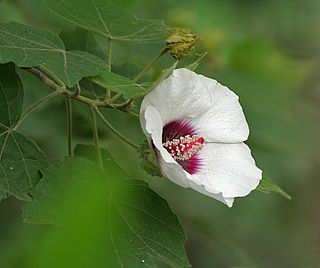
Hibiscus platanifolius, the maple-leaved mallow, is a species of flowering tree in the mallow family, Malvaceae, that is native to the India and Sri Lanka. In Sri Lankan texts, the plant is widely known by its synonym H. eriocarpus. The tree is about 8m tall. Leaves are cordate at base; hairy; trilobed. Flowers show axillary panicles where flowers show typical Hibiscus flower colors, pink with dark center. Fruit is a capsule.
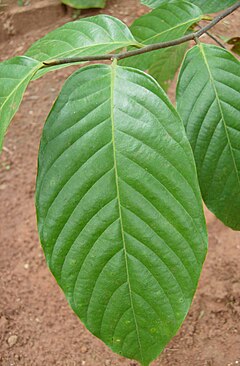
Dysoxylum gotadhora is a tree in the family Meliaceae. It is native to Bhutan, India, Laos, Nepal, Thailand, Vietnam. The name Dysoxylum ficiforme (Wight) Gamble in India and Sri Lanka is categorized as the same plant.

Bhesa indica is a flowering plant tree species in the Centroplacaceae family. It is distributed along the tropical wet evergreen forests of the Western Ghats of India. It is considered synonymous with Bhesa paniculata by some authors.
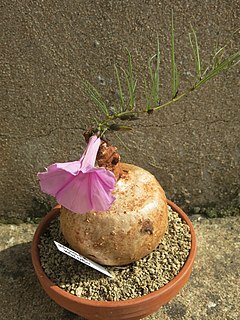
Ipomoea holubii is a species of flowering plant in the family Convolvulaceae.

Sri Lanka is a relatively small continental island, it exhibits a remarkable diversity of forest types, which are among the biologically one of richest forests in Asia. In these forests plant species show extraordinary patterns of localized distribution. Sri Lanka's forest became one of highest density of species diversity in the world. Sri Lanka natural forests cover about 12,493 km2 29.46% According to the National Red List said, Sri Lanka counts 253 land species, 245 species of butterflies, 240 birds, 211 reptiles, 748 evaluated vertebrates and 1,492 invertebrates. Forest coverage is about 70% tropical dry monsoon forests, 15% tropical moist monsoon forests and 5% tropical lower montane forests. By the dawn of the 19th century, Sri Lanka's forest cover was estimated at up to 70% of the total land area. Since then, the forest cover has decreased progressively over time. Significant loss of Sri Lanka's forest cover was first reported in the 19th century, with the introduction of plantation agricultural crops such as tea and vegetables. Commercial timber extraction policy of colonial rulers (British colonial time also led to clearing of forests in the dry zone. Irrigation development and agricultural expansions have been identified as key drivers of forest cover change.
